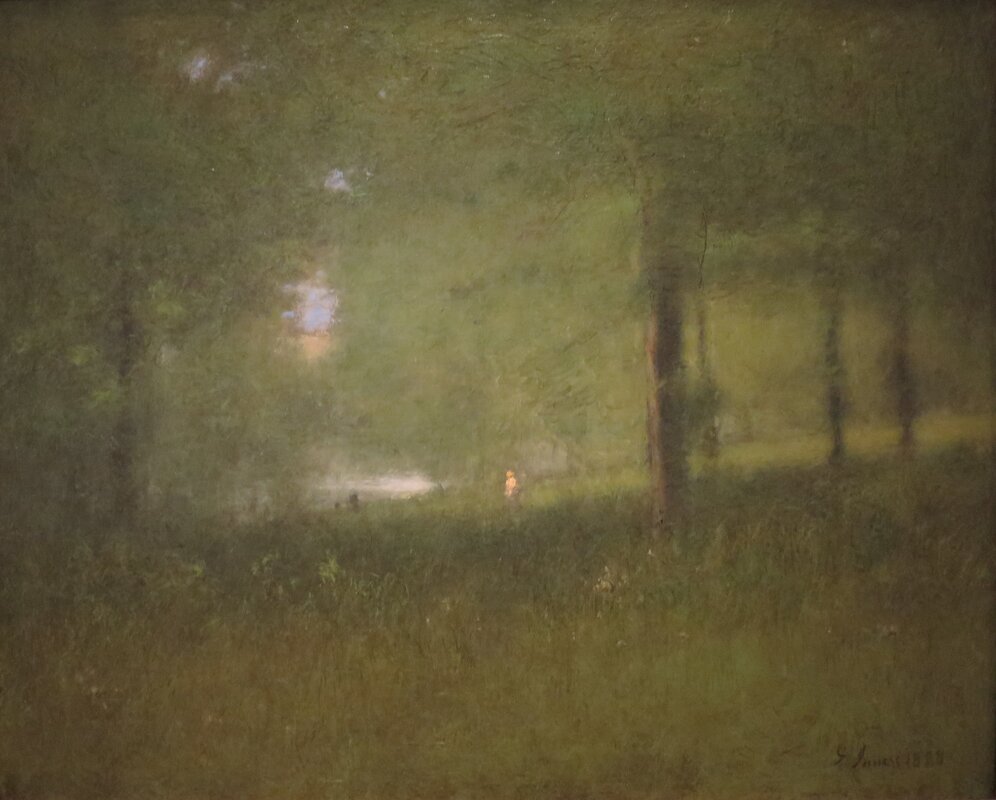A Glimpse of the Lake. A muted scene suggests a quiet shade of isolation. Every character present, human or not, serves to reinforce this feeling. The tiny figures enveloped by nature and the glimpse of the lake play out a miniature drama that seeps into the whole world of the painting. Isolation and melancholy are inseparable from this piece, like colors to light.

A bright yellow speck is the easiest thing to notice here. Rendered in a couple blobby strokes, it faces the glimpses of the lake and sky, maybe in movement. Following its loosely defined gaze leads the eye to more dark figures closer to the shoreline. The golden paint could be a flower, or a woman colored by sunlight. The black spots, one body stooped over and one head bobbing above the water, are also the remains of a dock. The only truth to be grasped is emotional. Whatever forms the colors assume to you, there’s a relationship held between them. The blonde, nearer to the viewpoint, is the focus. She is centered on the canvas, contrasts her surroundings, and carries motivation. Our shared interest, the lake, creates empathy. The shadowed impressions are even less defined. They are dark and round. As individuals, they do not matter. They are other. So here, already, a dynamic is established. There’s so much to see in these specks alone.
But most of the painting isn’t speckled. After adjusting, the eyes travel out, taking in the texture of the scene. Thick brushstrokes compose lush green foliage, and fine blades of grass flatten up against browns and yellows like old film. The warm light has a hazy, faded quality to it, too, that swallows and blurs tree trunks but clarifies water and sky. At this scale, the glimpse of the lake is the focus, and the trees become suggestions. Imagined nature, not impartial, directs what is seen in a piece. Keeping the figures center, a swath of composed light cuts through the deep greens swallowing the peripheries. Those wells of dense growth let in a gentle foreboding at the blonde’s back, beckoning her on through the brush. Lingering at the edge of the dark goes against her momentum. Drama.
There’s something innocent in the naming of the painting. Short of its composition, the subject matter is idyllic. It’s reminiscent of the worries of a young child, the others up ahead, soon to be bursting through into the sun yourself. The scene pauses at the point of removal, not left behind… but not entirely accounted for either. A glimpse of melancholy from the edge of alone. I remember so many of these moments. A Glimpse of the Lake is the verb, but the proper noun is a feeling that resists naming. It’s in the figures, the light, the trees. I stayed behind at the De Young museum, after everyone had taken their pictures and left, to give more time to the painting. Locked in a conversation with George Inness’ composition among a crowd of drifting students, basking in a growing feeling of separation from the departing surveyors, I felt its little world grow to include me. The relationships expressed in the paint lept from the frame and I was as inalienable a part of the production as the light and color, the viewer. The art has space for your melancholy, joy, and longing. Don’t let a glimpse of the lake stop you from hanging back for a moment to see the forest for the trees.

Your gaze wanders...
Guernica in Sand Performance
Golden Gate Magnificent Magnolias
77 Million Paintings